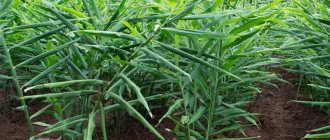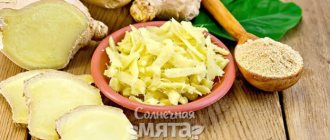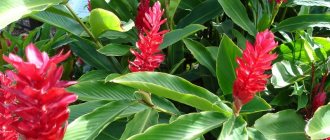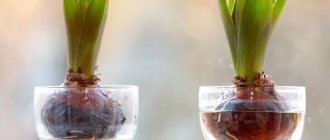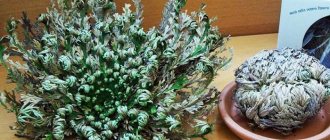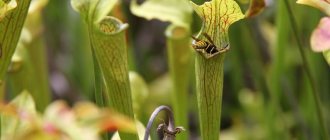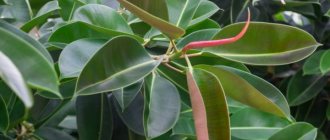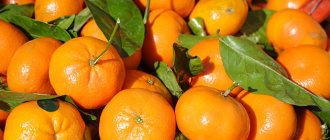OgorodGuruCom
Tips and tricks for gardeners
Popular
How to permanently remove horse sorrel from the site
Home › Herbs and Spices › Is it possible to grow ginger in Russia and what is needed for this
Ginger is a perennial herb that is widely used in cooking, medicine and cosmetology. Gardeners make every effort to grow this subtropical plant, but the results are not always positive.
Description of ginger
The structure of ginger deserves special attention:
- Root. The rhizome is light brown, branched, fleshy, forming a row of tubers up to 10 cm long.
- The stems grow from rhizomes that are covered with long leaves. The height of barren shoots is approximately 100 cm. The length of flowering shoots is much shorter.
- Leaves. The shape is lanceolate. The leaves are long, completely cover the stem, and grow in 2 rows.
- The flowers are large, yellow, green-yellow with an admixture of violet or purple.
- Fetus. In appearance it resembles a bag.
Important! You can tell that a plant is ripe by its leaves: they turn yellow and fall off.
Useful qualities of the root
Due to its special composition, the ginger plant is widely used in folk and official medicine. It is used to improve the functioning of the digestive system, reduce abdominal cramps, and also prevent putrefactive processes. The root is used as a prophylactic after meals, which speeds up metabolism and prevents heartburn and bad breath.
Ginger is useful in the fight against viral diseases, purulent sore throat and bronchitis. It helps strengthen the immune system and has a warming and expectorant effect. Teas and decoctions based on roots are an effective remedy for colds. Ginger is also used for skin lesions, boils or ulcers.
Other beneficial qualities of the plant include:
- Positive effect on the cardiovascular system. Ginger tones the heart muscles and reduces cholesterol levels in the blood. It has an antithrombotic effect.
- Improving blood circulation in the brain area. Because of this property, ginger roots are indicated for older people who are experiencing natural age-related changes, including memory loss.
- Improved mental health. Drinking ginger tea lifts your mood, energizes your body and fights depression.
In addition, the plant is a strong aphrodisiac - it helps improve male potency and libido. Senegalese women wear a ginger belt to attract interest from the opposite sex. The root is also used to prevent tumors.
Regular intake of ginger promotes weight loss, making it a valuable alternative for various diets. The product does not burn calories, but improves the functioning of the thyroid gland and accelerates metabolic processes in the body. It is also characterized by laxative and diuretic effects.
If you drink ginger-based decoctions before meals, this will eliminate the feeling of hunger. Such drinks break down proteins and fats, and also remove waste, toxins, radionuclides and other harmful substances from the body.
When understanding what ginger is and its health benefits, it is important to consider its positive effects on the skin. Teas based on the plant fight pores and blemishes on the skin, stop the aging process and improve the functionality of the immune system.
Ginger-based preparations are produced by the pharmaceutical industry and sold in pharmacies. However, the most effective dosage form is tincture. To prepare it, you will need to take 200 g of roots, peel them, chop them finely and throw them into a liter jar. Next, the components are filled with 40% alcohol or vodka. The solution must be infused for 2-3 weeks, stirring regularly. Then it should be strained. To reduce the bitter taste, you can add 30 g of honey to the composition. Take the drug 2 times a day, 5 g.
Despite the absence of significant contraindications, certain types of ginger may have properties that cause discomfort in people. In most cases, they are associated with individual intolerance to the components.
Ginger-based preparations are also not recommended for people who are prone to bleeding, because... they can thin the blood. You should not use them before surgery.
Due to its choleretic effect, the root increases the likelihood of gallstone disease. A certain group of people may suffer from an allergic reaction to the active components of the composition.
Distribution history
The history of the spread of spice is closely connected with the countries of South Asia. Chinese sailors used ginger tincture as a medicine to treat nausea and seasickness. Over time, rumors about the miracle cure spread among sailors and discoverers.
In the Middle Ages, during an expedition, the Italian traveler Mark Polo brought ginger to Europe. The Romans appreciated the beneficial properties of the plant and began to use it as a cosmetic and seasoning.
The culture was brought to America at the beginning of the 16th century and gained popularity in record time.
Important! In the Middle Ages, the plant was believed to have miraculous properties that helped fight the plague.
The history of the plant begins BC. e.
Homeland of the plant
Residents of European countries have been eating ginger root since the 9th-12th centuries (the exact date is not known). It was brought by Arab merchants who traded spices. But the Arabs kept the secret of ginger germination a secret; to all questions they answered that the plant sprouts at the end of the world. With such stories and descriptions of the place where ginger sprouts, they raised the price of spices.
On a note!
Initially, only wealthy noble people could buy ginger, but since 1818 the spice has become widespread.
The homeland of this plant is considered to be East and South Asia (Indonesia, India, China). For active development, perennials need moisture and warmth. A true variety of ginger with medicinal properties, it grows in the shade of the tropics.
There are plantations of different varieties in different countries (Australia, Jamaica, Japan, Africa, South America, Vietnam).
Where are you from?
Ginger, whose homeland is located in Southeast Asia, is a rather capricious crop. The warm tropical climate is considered the most comfortable place for a light-loving culture.
Scientists have established that the first use of the plant occurred in the 2nd century BC. e. in ancient India and China, where it was believed that the smell of the plant repels evil spirits.
Nowadays, India is the main supplier from where ginger is brought to Russia and other countries. In addition to India, the plant is grown in China, Japan, West Africa and Vietnam.
Kinds
There are two types of ginger: wild and cultivated.
Wild
Wild, in appearance it resembles reeds or reeds. It is distinguished by a thick rhizome with many branches. The crop growing in the wild can reach a height of up to 2 meters.
Cultivated
A feature of the cultivated species is the lack of need for special care. In subtropical and tropical climates, the plant is planted like potatoes. Cultivated ginger reaches a height of up to 160 cm.
It is almost impossible to find culture in the wild
Final conclusions
- Chamomile has been used for medicinal purposes since 5,000 years ago. Since then, people around the world have highly valued this plant for its therapeutic and healing properties.
- Chamomile helps relieve irritation and relaxation. This plant has a mild calming effect, helps relieve inflammation, pain and provides sound sleep. It also has antimicrobial properties, thereby helping to fight infections.
- Chamomile is available in many forms: tea, extract, capsules, powder and essential oil.
- Can you drink chamomile tea every day? This is completely safe, but women during pregnancy or with hormonal disorders should first consult with a specialist.
You can make an appointment with an oncologist on our website.
Growing methods in Russia
Many gardeners who respect this crop are wondering where ginger grows in Russia and how to grow it on their site. So, it is worth noting that even if it can be grown in our country, then only in a greenhouse or at home; an open plot in the garden is not suitable for this purpose.
At home
A ginger tree can be grown on a windowsill in an ordinary city apartment, using seeds and rhizomes. However, for the process to be crowned with success, it is necessary to treat it with special trepidation and attention.
Important! At home, Russian ginger is grown as an annual.
Growing a culture in your own home is not difficult, it is important to pay special attention to it
Seeds
This method is very complicated, so it is rarely used. For the process to be successful, it is necessary to choose selected planting material.
So:
- For sowing you will need loose, fertile soil and a shallow container.
- The pot with soil is moistened with settled, warm water.
- The seeds are distributed on the surface of the soil and sprinkled with a thin layer of substrate.
- It is forbidden to moisten crops.
- The container is covered with transparent material.
- If planting was done correctly, the first shoots will appear within 20-30 days.
- You need to keep the seedlings on the window, providing them with darkness in the heat.
- Watering is carried out with a thin stream of water along the edge of the container.
- When the first leaves form, the shoots need to be planted in different containers.
In greenhouses
It takes about 8 months to grow ginger from rhizomes in a greenhouse.
They work like this:
- Before planting, the rhizomes are germinated at home, starting in February.
- For planting, it is necessary to choose loose and nutritious soil, as well as a container with a drainage layer of about 3 cm. The rhizomes are watered once, then avoid watering until the first shoots form.
- In the spring, when the temperature in the greenhouse reaches 22 to 25 degrees Celsius, seedlings begin to be transplanted. To do this, you will need to prepare holes 15 cm deep. The buds of the seedlings should be above the soil, and the distance between the seedlings should be 10-15 cm.
- Seedlings should be watered abundantly, and the soil should be loosened to a depth of 1 cm after watering.
Important! If the sun's rays fall on the garden bed, you need to organize artificial darkening.
Ginger does not tolerate prolonged sun exposure.
Growing conditions and care
Regardless of the growing method, it is necessary to create comfortable conditions for the growth of the crop:
- the plant prefers areas where the sun is present until 12 noon;
- absolutely does not tolerate drafts;
- Temperatures from 18 to 20 degrees Celsius are suitable for maintenance; at temperatures below 14 degrees Celsius, the culture dies.
Interesting Facts
This plant has long been loved by the inhabitants of Russia. The use of spices has its own history:
- The description of ginger root accurately reflected its appearance. The intertwined thick rhizome amazed people. The vegetable is still called “stag”.
- Gingerbread cookies soon began to be called “gingerbread” because of their spicy taste. This component is still used in recipes today.
The root is most often eaten. But beneficial substances are contained in the stem and leaves. They are also recommended to be used
But it is important to consider: removing each leaf weakens the plant. The root will be thin and tasteless. Spicy vegetable popular all over the world
Countries where ginger is grown receive up to 30% of the total trade turnover from its sales.
- Under natural conditions, the plant grows above 1.5 m. Planted at home it is rarely higher than half a meter.
- Some people like the specific lemony smell of the plant. It is emitted by terrestrial parts. A flower placed on the windowsill refreshes the air.
- When choosing planting material, gardeners will have to work hard. Sellers break off parts of the plant with eyes: the sprouted root loses its elasticity and shrinks.
- In medieval Europe, the vegetable was considered an excellent aphrodisiac. It was included in love potions. Modern medicine uses the properties of the spice to create drugs to increase potency in men. Natural remedies for erectile dysfunction include root extract.
- Anyone can grow ginger. The technique replicates the cultivation of potatoes. But keep in mind: before use, it should be soaked in cold water for 2-3 hours. Change the water every half hour. It is recommended to try in small pieces (otherwise you may get a burn to the mouth and esophagus).
- Before planting roots, you should familiarize yourself with the climate of the regions where ginger is grown. It is recommended to visit the sites of famous plantations. This will help create the necessary conditions.
- Doctors are convinced that fresh and dried roots act differently. Preparations from the fresh plant treat colds. Dried - helps with memory loss, gastrointestinal problems, rheumatism, arthritis.
- The properties of ginger root are used in everyday life. To purify the air from harmful bacteria, it is enough to place the root cut into pieces in different parts of the room. Tea made from it will relieve sore throats. Adding it to food will strengthen the immune system in the autumn-winter period.
Uncontrolled long-term consumption of vegetables causes poisoning and depression. The product is not recommended for use by people with allergic diseases.
Treatment with root preparations should be under the supervision of a physician.
Consequences of unsuitable climatic conditions
If ginger is planted in an environment unsuitable for it, then it is likely that a good harvest will not be possible. If a plant is planted in unsuitable climatic conditions, the consequences may be as follows:
- the culture will look sick;
- the above-ground mass turns yellow and rots;
- height below the accepted norm;
- root vegetables are small in size.
It is important to know not only where ginger is obtained, but also how to grow it correctly. Growing this crop in the Russian Federation is a kind of know-how. The process itself is long and complex, but the end result is an environmentally friendly, organically grown vegetable.
Risks and side effects
Chamomile is considered "possibly safe" when taken in recommended amounts and "probably safe" when used topically or internally for a short period of time.
Essential oil should be used externally; Try it on a small area of skin first to rule out an allergic reaction.
Chamomile oil is not recommended for people suffering from any seasonal allergies, for example to plants of the genus Ambrosia, as they may also be sensitive to chamomile. If you suffer from hay fever, hives and dermatitis, we also advise you to avoid using products containing this herb or at least consult your doctor. If an allergic reaction occurs, you will experience itching, drowsiness, and breathing problems.
Horseradish helps fight respiratory diseases, imp and cancer
In women suffering from hormonal disorders such as endometriosis, fibroids, cervical, breast or ovarian cancer, chamomile can act as estrogen in the body, so it is better to avoid it.
It is also worth remembering that products containing chamomile can affect uterine contractions, so during pregnancy you should consult a doctor before consuming them (weak chamomile tea, as a rule, does not have any adverse effects).
